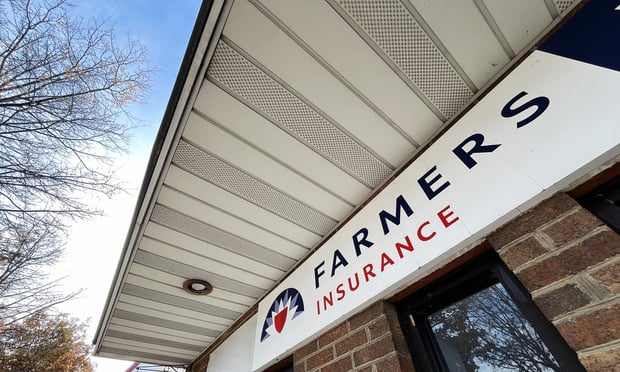This story is reprinted with permission from FC&&S Legal, the industry’s only comprehensive digital resource designed for insurance coverage law professionals. Visit the website to subscribe.
A federal district court in Colorado has ruled that a “broad exclusion” for earth movement in a homeowner’s insurance policy precluded coverage for damage that resulted when a large rock detached from a cliff and struck and damaged the insured's home.
|Homeowner's insurance claim denied
On April 20, 2016, a large rock detached from a cliff face roughly 1/4 mile from the home owned by John and Arlene Bulinski near Ouray, Colorado, striking their home, breaking through the south wall and first floor, and lodging in the basement.
The Bulinskis made a claim under the homeowners’ insurance policy they had acquired from State Farm Fire and Casualty Company.
State Farm denied coverage on the ground that the loss had been caused by “earth movement” within the meaning of a policy exclusion.
The Bulinskis sued, and the parties moved for summary judgment.
|What specific force caused rock to break free?
The Bulinskis argued that the flaw in State Farm’s denial of coverage was that it had not determined, in its investigation of the claim, what specific force had caused the rock to break free, and consequently it never had, and could not, articulate how any particular seismic, geological, or other force that generally would be considered “earth movement” had anything to do with the event.
Therefore, they argued, State Farm could not meet its burden of proving that the earth movement exclusion applied and that the exclusion was “not subject to any other reasonable interpretations.”
The State Farm policy provided:
|LOSSES NOT INSURED
2. We do not insure under any coverage for any loss which would not have occurred in the absence of one or more of the following excluded events. We do not insure for such loss regardless of: (a) the cause of the excluded event or (b) other causes of the loss; or (c) whether other causes acted concurrently or in any sequence with the excluded event to produce the loss; or (d) whether the event occurs suddenly or gradually, involves isolated or widespread damage, arises from natural or external forces, or occurs as a result of any combination of these:
* * *
b. Earth Movement, meaning the sinking, rising, shifting, expanding or contracting of earth, all whether combined with water or not. Earth movement includes but is not limited to earthquake, landslide, mudflow, mudslide, sinkhole, subsidence, erosion or movement resulting from improper compaction, site selection or any other external forces. Earth movement also includes volcanic explosion or lava flow, except as specifically provided in SECTION I - ADDITIONAL COVERAGES, Volcanic Action.
Decision favors State Farm
The district court granted summary judgment in favor of State Farm.
In its decision, the court explained that there was no dispute that for no known specific reason a large rock had broken loose and fallen, causing the Bulinskis’ loss. The district court pointed out that State Farm had obtained an expert opinion that, to a reasonable degree of engineering probability, erosion, expansion/contraction of the earth due to abundant and abnormally high moisture, and ice seeping into crevices in a cliff face had caused the rock to fall. The district court said, however, that it was “not necessary to consider that opinion” to determine that the earth movement exclusion applied.
The district court reasoned that if a loss would not have occurred in the absence of “earth movement” as defined in the policy, the “lead-in” language of the exclusion “unambiguously” excluded coverage for losses caused by earth movement as defined by the exclusion.
Here, the district court continued, the Bulinskis’ loss had been caused by the movement of a large rock. That event “clearly and unambiguously” fell within the policy definition of earth movement, according to the district court, whether it was considered to be one of the “included but not limited to” named examples — such as erosion or landslide — or simply to fall within the broader language excluding “the sinking, rising, shifting, expanding or contracting of earth,” and “movement resulting from … any other external forces.”
|Court rejects homeowner's arguments
The district court also rejected the Bulinskis’ argument that coverage was provided by the policy’s “falling object” provision, concluding that regardless of the provision under which coverage was claimed, the policy’s exclusion section “plainly” stated:
We do not insure under any coverage for any loss which would not have occurred in the absence of one or more of the following excluded events….” (Emphasis added.)
This exclusion, the district court ruled, applied to the “falling object” coverage, even if that applied.
In short, the district court concluded, by writing this “broad exclusion for earth movement,” State Farm had not accepted this risk of loss.
The case is Bulinski v. State Farm Fire and Cas. Co., No. 16-cv-02066-RPM (D. Colo. June 7, 2017).
Steven A. Meyerowitz, Esq., is the director of FC&S Legal, the editor-in-chief of the Insurance Coverage Law Report, and the founder and president of Meyerowitz Communications Inc. Email him at [email protected].
Want to continue reading?
Become a Free PropertyCasualty360 Digital Reader
Your access to unlimited PropertyCasualty360 content isn’t changing.
Once you are an ALM digital member, you’ll receive:
- Breaking insurance news and analysis, on-site and via our newsletters and custom alerts
- Weekly Insurance Speak podcast featuring exclusive interviews with industry leaders
- Educational webcasts, white papers, and ebooks from industry thought leaders
- Critical converage of the employee benefits and financial advisory markets on our other ALM sites, BenefitsPRO and ThinkAdvisor
Already have an account? Sign In Now
© 2024 ALM Global, LLC, All Rights Reserved. Request academic re-use from www.copyright.com. All other uses, submit a request to [email protected]. For more information visit Asset & Logo Licensing.








